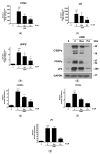Piceatannol Is Superior to Resveratrol at Suppressing Adipogenesis in Human Visceral Adipose-Derived Stem Cells
- PMID: 33672932
- PMCID: PMC7918058
- DOI: 10.3390/plants10020366
Piceatannol Is Superior to Resveratrol at Suppressing Adipogenesis in Human Visceral Adipose-Derived Stem Cells
Abstract
Resveratrol (3,4',5-trans-trihydroxystilbene) and piceatannol (3,3',4',5-trans-tetraphydroxystilbene) are major stilbene compounds that are predominantly present in various natural foods, such as berries and fruits. Both phytochemical compounds are consumed as dietary supplements to prevent various metabolic diseases and for their anti-aging properties. Adipose-derived stem cells from human visceral adipose tissue (vASCs) are a useful in vitro model for evaluating their adipogenic effect. Treatment with resveratrol and piceatannol significantly inhibited lipid accumulation in vASCs. Their effective concentrations were 5, 10, and 20 μM for inhibiting adipogenesis of vASCs. Interestingly, despite the similar chemical structures of the two compounds, piceatannol showed a higher anti-adipogenic effect at 20 μM than resveratrol in vASCs. Moreover, the inhibitory capacity of lipid droplet generation was higher for piceatannol at 20 μM than that of resveratrol. Piceatannol significantly attenuated the expression level of adipogenic markers (e.g., CCAAT/enhanced binding protein α (C/EBPα), peroxisome proliferator-activated receptor γ (PPARγ), and adipocyte fatty acid binding protein (aP2)) compared to resveratrol at the mRNA and protein levels. These results suggest that piceatannol is a superior anti-adipogenic compound compared to resveratrol in the vASC model of visceral obesity.
Keywords: adipogenesis; human visceral adipose-derived stem cells; obesity; piceatannol; resveratrol.
Conflict of interest statement
The authors declare no conflict of interest.
Figures




References
Grants and funding
LinkOut - more resources
Full Text Sources
Other Literature Sources
Research Materials

